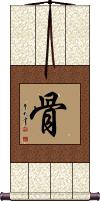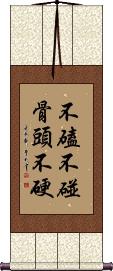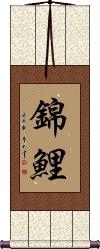Many custom options...
And formats...

Bones in Chinese / Japanese...
Buy a Bones calligraphy wall scroll here!
Personalize your custom “Bones” project by clicking the button next to your favorite “Bones” title below...
Bones
骨 is Chinese, Japanese, and Korean for bone or bones.
If your name happens to be Bone or Bones, this is a cool character for a wall scroll to hang in your home or office.
Strong bones come from hard knocks
不磕不碰骨頭不硬 is a Chinese proverb that literally translates as: Without being knocked around a bit, [one's] bones won't become hard.
Figuratively, this means: One can't become strong without first being tempered by “hard knocks.”
While true for everyone, this sounds like the “Iron Body” form of Kung Fu, where practitioners' bodies are beaten (and often bone fractured) in order to become stronger.
For the rest of us, this is just about how we can be tempered and build character through the hardships in our lives.
This is not a common title for a wall scroll in China.
Iron Palm
鐵掌 means “iron palm,” the martial arts technique taught by Brian Gray and others.
This term can mean different things to different people. The consensus is that rather than a type or style of martial arts, this is a technique for refining hand position and strengthening hands to strike blows with maximum force and effect.
The regime may include herbal treatments and special exercises to fortify the hands.
In more extreme versions, the carpals and metacarpal bones in the hand are systematically broken so that when they heal, they will become stronger.
Japanese note: This does make sense in Japanese (though the version shown above is the ancient form of the first Kanji), this is far from a commonly-known term.
Koi Fish / Nishiki Goi
If you like or collect and maintain koi fish, 錦鯉 is the wall scroll for you.
Technically, this is a certain and revered species of “koi fish” in Japan, but it is the most normal selection for a wall scroll (more normal than the actual Kanji for “koi” or “fish” alone.
This literally means “brocade carp” or “embroidered carp.” This term is also used to mean the same thing in China (which is the origin of koi fish breeding and cultivation, several generations before they became popular in Japan).
For those of you that don't know, the Kanji for “koi” (which is pronounced “goi” in this entry) really means “carp.” If you want the word that means “koi fish,” it would just be the generic word for “carp fish.” That would include both colorful carp and the more mundane gray carp (the ones people eat if they don't mind lots of bones).
Not the results for bones that you were looking for?
Below are some entries from our dictionary that may match your bones search...
| Characters If shown, 2nd row is Simp. Chinese |
Pronunciation Romanization |
Simple Dictionary Definition |
塔 see styles |
tǎ ta3 t`a ta tousaki / tosaki とうさき |
More info & calligraphy: Ta(n,n-suf) (1) tower; steeple; spire; (2) (abbreviation) (original meaning) (See 卒塔婆・1,塔婆・1) stupa; pagoda; dagoba; (surname) Tousaki stūpa; tope; a tumulus, or mound, for the bones, or remains of the dead, or for other sacred relics, especially of the Buddha, whether relics of the body or the mind, e.g. bones or scriptures. As the body is supposed to consist of 84,000 atoms, Aśoka is said to have built 84,000 stūpas to preserve relics of Śākyamuni. Pagodas, dagobas, or towers with an odd number of stories are used in China for the purpose of controlling the geomantic influences of a neighbourbood. Also 塔婆; 兜婆; 偸婆; 藪斗波; 窣堵波; 率都婆; 素覩波; 私鍮簸, etc. The stūpas erected over relics of the Buddha vary from the four at his birthplace, the scene of his enlightenment, of his first sermon, and of his death, to the 84,000 accredited to Aśoka. |
骨 see styles |
gǔ gu3 ku hone ほね |
More info & calligraphy: Bones(1) bone; (2) frame; (3) outline; core; (4) backbone; spirit; fortitude; (noun or adjectival noun) (5) laborious; troublesome; difficult; (personal name) Hone Bone: bones, relics. |
剔 see styles |
tī ti1 t`i ti teki てき |
to scrape the meat from bones; to pick (teeth etc); to weed out cutting |
囟 see styles |
xìn xin4 hsin |
fontanel (gap between the bones of an infant's skull) |
殻 壳 see styles |
qiào qiao4 ch`iao chiao gara がら |
variant of 殼|壳[qiao4] (n,n-pref) (1) (kana only) (See 鶏がら) chicken bones (e.g. for soup); chicken carcass; (2) (kana only) poor-quality coke (coal); (suffix) (3) (kana only) left-overs; remnants |
磋 see styles |
cuō cuo1 ts`o tso sa |
(old) to polish bones, horns, ivory etc into tools; (bound form) to deliberate; to consult To polish; translit. cha; cf. 車, etc. |
胔 see styles |
zì zi4 tzu |
rotten meat; bones of dead animal |
脫 脱 see styles |
tuō tuo1 t`o to datsu |
to shed; to take off; to escape; to get away from To take the flesh from the bones; to strip, undress, doff; to escape, avoid; let go, relinquish. |
膠 胶 see styles |
jiāo jiao1 chiao nikawa にかわ |
to glue; glue; gum; rubber gelatinous glue (usu. from animal and fish bones, hide, etc.) Glue, gum. |
菹 see styles |
zū zu1 tsu |
marshland; swamp; salted or pickled vegetables; to mince; to shred; to mince human flesh and bones; Taiwan pr. [ju1] |
顳 颞 see styles |
niè nie4 nieh komekami こめかみ |
bones of the temple (on the human head); see 顳顬|颞颥, temple (kana only) temple (of the forehead) |
顴 颧 see styles |
quán quan2 ch`üan chüan |
cheek bones |
骫 see styles |
wěi wei3 wei |
be bent; crooked (of bones) |
骱 see styles |
xiè xie4 hsieh |
joint of bones |
骸 see styles |
hái hai2 hai kaiji かいじ |
bones of the body (dead) body; corpse; shell; husk; hull; pod; chaff; (personal name) Kaiji |
髀 see styles |
bì bi4 pi hi |
buttocks; thigh The pelvic bones, the rump. |
九想 see styles |
jiǔ xiǎng jiu3 xiang3 chiu hsiang kusō |
(九想觀) or 九相 navasaṃjñā. Meditation on a corpse in order to curb desire; one of the meditations on the unclean: vyādhmātakasaṃjñā, its tumefaction; vinīlakas., its blue, mottled colour; vipadumakas., its decay; vilohitakas., its mess of blood,etc.; vipūyakas., its discharges and rotten flesh; vikhāditakas., its being devoured by birds and beasts; vikṣiptakas., its dismembering; asthis., its bones; vidagdhakas., their being burnt and returning to dust. |
人骨 see styles |
jinkotsu じんこつ |
human bones |
佛骨 see styles |
fó gǔ fo2 gu3 fo ku bukkotsu |
Buddha's bones (as a sacred relic) A bone of the Buddha, especially the bone against whose reception by the emperor Xianzong the famous protest of Hanyu was made in 819. |
入塔 see styles |
rù tǎ ru4 ta3 ju t`a ju ta nyuttō |
To inter the bones or body of a monk in a dagoba; v. 入骨. |
入骨 see styles |
rù gǔ ru4 gu3 ju ku nyū kotsu |
To inter the bones (of a monk) in a stūpa, or a grave. |
剝皮 剥皮 see styles |
bāo pí bao1 pi2 pao p`i pao pi hakuhi |
to skin; to flay; to peel; (fig.) (coll.) to haul (sb) over the coals; also pr. [bo1pi2] To flay, or peel. In one of the previous incarnations of Śākyamuni he is said to have written a certain gāthā containing the Holy Law on a piece of his own flayed skin with one of his bones split into the shape of a pen, and his blood instead of ink. 智度論 27. |
卜辭 卜辞 see styles |
bǔ cí bu3 ci2 pu tz`u pu tzu |
oracle inscriptions of the Shang Dynasty (16th-11th century BC) on tortoiseshells or animal bones |
卜骨 see styles |
bǔ gǔ bu3 gu3 pu ku bokkotsu ぼっこつ |
oracle bone fortune-telling using animal bones |
厨子 see styles |
chuushi / chushi ちゅうし |
(1) miniature shrine with double doors (used to store important Buddhist items such as sutras, etc.); (2) cabinet with double doors (used by the nobility to store books, etc.); (3) (in Okinawa) carved and decorated stone container for storing the bones of one's ancestors; (surname) Chuushi |
収骨 see styles |
shuukotsu / shukotsu しゅうこつ |
(n,vs,vt,vi) (1) collecting bones and remains (e.g. on a battlefield); (n,vs,vt,vi) (2) putting cremated remains in an urn |
囟門 囟门 see styles |
xìn mén xin4 men2 hsin men |
fontanel (gap between the bones of an infant's skull) |
壞法 坏法 see styles |
huài fǎ huai4 fa3 huai fa ehō |
Any process of destruction, or decay to burn the bones of a deceased person so that they may not draw him to rebirth. |
宗骨 see styles |
zōng gǔ zong1 gu3 tsung ku shūkotsu |
The 'bones' or essential tenets of a sect. |
小骨 see styles |
kobone こぼね |
(noun - becomes adjective with の) small bones |
Click here for more bones results from our dictionary
The following table may be helpful for those studying Chinese or Japanese...
| Title | Characters | Romaji (Romanized Japanese) | Various forms of Romanized Chinese | |
| Bones | 骨 | hone / kotsu | gǔ / gu3 / gu | ku |
| Strong bones come from hard knocks | 不磕不碰骨頭不硬 不磕不碰骨头不硬 | bù kē bù pèng gǔ tóu bù yìng bu4 ke1 bu4 peng4 gu3 tou2 bu4 ying4 bu ke bu peng gu tou bu ying bukebupenggutoubuying | pu k`o pu p`eng ku t`ou pu ying pukopupengkutoupuying pu ko pu peng ku tou pu ying |
|
| Iron Palm | 鐵掌 铁掌 | tetsu-tenohira | tiě zhǎng tie3 zhang3 tie zhang tiezhang | t`ieh chang tiehchang tieh chang |
| Koi Fish Nishiki Goi | 錦鯉 锦鲤 | nishiki goi nishikigoi | jǐn lǐ / jin3 li3 / jin li / jinli | chin li / chinli |
| In some entries above you will see that characters have different versions above and below a line. In these cases, the characters above the line are Traditional Chinese, while the ones below are Simplified Chinese. | ||||
Successful Chinese Character and Japanese Kanji calligraphy searches within the last few hours...







